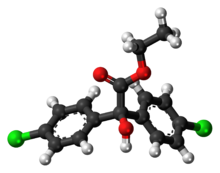
| |

| |
| Names | |
|---|---|
| Preferred IUPAC name
Ethyl bis(4-chlorophenyl)hydroxyacetate | |
| Other names
Chlorbenzylate; Chlorobenzylate
| |
| Identifiers | |
3D model (JSmol)
|
|
| ChEBI | |
| ChEMBL | |
| ChemSpider | |
| ECHA InfoCard | 100.007.374 |
| EC Number |
|
| KEGG | |
PubChem CID
|
|
| RTECS number |
|
| UNII | |
| UN number | 2996 |
CompTox Dashboard (EPA)
|
|
| |
| |
| Properties | |
| C16H14Cl2O3 | |
| Molar mass | 325.19 g·mol−1 |
| Appearance | Colorless to pale yellow solid |
| Density | 1.28 g/cm3 |
| Melting point | 37 °C (99 °F; 310 K) |
| Hazards | |
| GHS labelling: | |
 
| |
| Warning | |
| H302, H410 | |
| P264, P270, P273, P301+P312, P330, P391, P501 | |
Except where otherwise noted, data are given for materials in their standard state (at 25 °C [77 °F], 100 kPa).
| |
Chlorobenzilate is a pesticide that is not currently used in the United States or Europe. It was originally developed by Ciba-Geigy and introduced in 1952.[2] It was used as an acaricide against mites on citrus trees, including deciduous fruit trees.[3] It has been detected as a residue on tomatoes found in Japanese markets in 2005.[4] It is a non-systemic pesticide that works through contact and as a neurotoxin: it disrupts the functioning of the nervous system.
In the pure state, chlorobenzilate is a colorless to pale yellow solid, but the commercial product is a brownish liquid.[3] It is only slightly soluble in water, but miscible with acetone, toluene and methanol.
- ^ International Chemical Safety Card for chlorobenzilate, National Institute for Occupational Safety and Health
- ^ Chlorobenzilate, International Agency for Research on Cancer
- ^ a b Chlorobenzilate, U.S. Environmental Protection Agency
- ^ Ochiai, Nobuo (2005). "Optimization of a multi-residue screening method for the determination of 85 pesticides in selected food matrices by stir bar sorptive extraction and thermal desorption GC-MS". Journal of Separation Science. 28: 1083–1092. doi:10.1002/jssc.200500017.